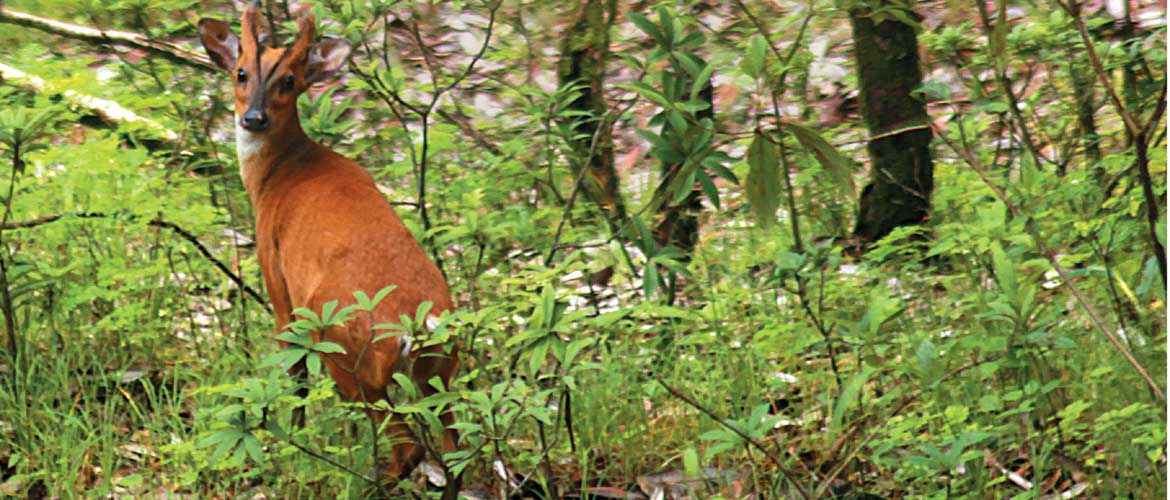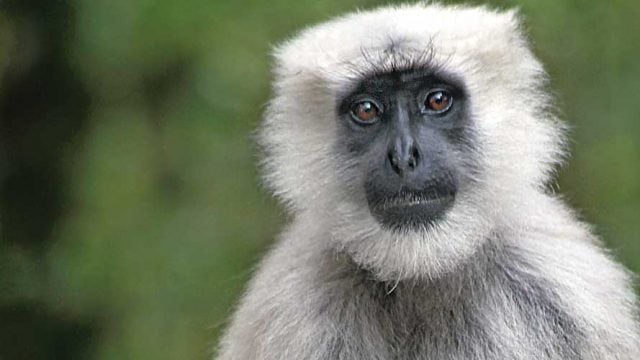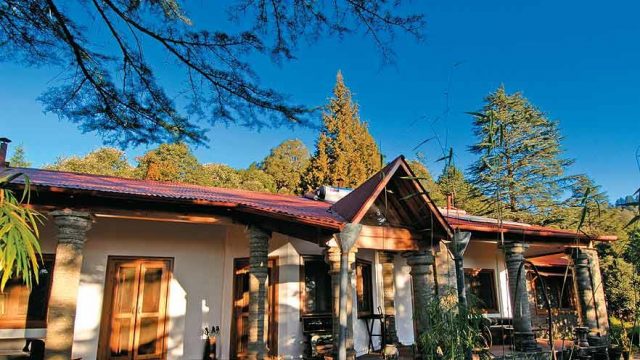Binsar Wildlife Sanctuary is a small protected area, enclosing only 47.04sq km of the heavily-forested
The forest cover is mostly of oak and rhododendron at higher altitudes and chir pine trees at lower elevations. Though, Binsar is home to the leopard, ghoral, kakar, wild boar, Himalayan black bear, jackal, Indian red fox and porcupine, the sightings are mostly occasional, and usually in ones and twos. In spite of this, one does get to see the elusive leopard if one is lucky. Bird-watching is, however, easier as around 200 species of resident and migratory birds have been recorded within the sanctuary. There is one entry gate for tourists at Ayarpani, located on the south-east edge of the sanctuary, and only one road, climbing in a north-westerly direction to terminate at the Forest Rest House (FRH) located near the core zone.
◆Entry Indians ₹150; Foreigners ₹650 Vehicle entry ₹250 Guide Half Day ₹600 Full Day ₹1,200
Tip Book your guide at the sanctuary gate in advance
THINGS TO SEE AND DO
Walks in the Forest
Unlike many other national parks in the plains, jeep or elephant safaris are not the means for exploration here – walking is. There are many trails crisscrossing the sanctuary – some are relatively wide and well-trodden, while others are barely discernible. If planning to venture alone, be aware that not only is it easy to get lost, but you would also lose out on the benefit of a guide who can make your experience enriching.
Mountain Views
The stunning views of the snow-clad Greater Himalaya mountain range, a big draw at Binsar, is truly breathtaking. The 300-km line-up stretches all the way into Nepal and includes some of the celebrated giants: Kamet, Mana, Gauri Parbat, Hathi Parbat, Trishul, Maiktuli, Mrigthuni, Nanda Devi, Panvali Dwar, Nanda Devi East, Nanda Khat, Chhanguchh, Nanda Kot, Hardeli, Pandav Parbat, Api, Nampa, Panchachuli and Machhapuchhare. The best time to catch the panorama is in March–April or September–October, when the weather is clear.
Bineshwar Temple
The 16th-century Shiva shrine from which Binsar takes its name is set in a clearing by the road, 6km from Ayarpani. It can be visited while driving upto the reserve. It was built by the Chand Rajas, who had their summer capital at Binsar.
WHERE TO STAY
Stay options are available both within and outside the park. If wildlife and walks in the forest are the focus of your trip, it is preferable to stay inside.
Within the sanctuary
KMVN’s Nanda Devi Tourist Rest House (Cell: 08650002537; Tariff: ₹2,400–4,200) offers astounding panoramic views from the terrace deck and is a nodal point for many of the walks. The cottages are clean and comfy. However, there are no amenities like room service or electricity; the generator is used for only three hours.
Tip Snowfall in December–January often blocks the road above the temple and you may have to trek for 4km.
About 2km from Ayarpani, Mountain Resort Khali Estate (Cell: 09639989902, 09456566685; Tariff: ₹ 5,750 per person, with breakfast and dinner) has 15 cottages. The library and living room of the historic bungalow, with old black-and-white photographs of its erstwhile residents, are open to guests.
Binsar Forest Retreat (Cell: 08191920725, 07055104970; Tariff: ₹9,000–12,000, inclusive of break-fast and dinner) has luxury tents and cottages. The rooms feature solar lighting and modern baths.
Also inside the sanctuary is the luxurious Mary Budden Estate (Cell: 09810031753, 09711171350; Tariff: ₹ 22,900, with meals), which has gorgeous interiors and a great location. It is operational from September to June.
The Forest Rest House (Tariff: ₹2,000) offers privacy at a great location in the heart of the sanctuary. The caretaker can prepare your meals, so carry provisions with you. Bookings can be made at the Range Office in Almora (Tel: 05962-230229).
Outside the Sanctuary
On the Bageshwar Road, 17km from Ayarpani, the Club Mahindra Binsar Valley Resort (Cell: 08392-910580; Tariff: ₹7,000) has deluxe suites and cottages with kitchenettes and sprawling lawns.
Kasaar Jungle Resort (Tel: 251127, Cell: 09560937103; Tariff: ₹4,000–5,500), set in a pine grove, has modern cottages. A little further down on the main road, Kalmatia Sangam Himalaya Resort (Tel: 251101/ 76; Tariff: ₹7,000–12,800) is a stylish property. The food is made with local, organic produce.
The YMCA Campsite (Tel: 251151–54, Cell: 09368002081; Tariff: ₹700 per person, dorm bed: ₹100) at Pokhratal is a good budget option. The Dinapani Forest Rest House (Tel: 230229; Tariff: ₹750), on Almora Road, is as basic as its Binsar counterpart. About 17km from Ayarpani, at Dhaulachhina, on the eastern fringe of the sanctuary, Binsar Eco Camp (Cell: 09675544799; Tariff: ₹1,500 per person, with breakfast and dinner) has beautiful cottages.
WHERE TO EAT
If you discount the ragged assortment of dhabas, for variety’s sake, there’s Dolma’s, near the Kasar Devi Temple, which rustles up momos, some greasy chowmein and lemon chicken. In the Binsar area, the eating is where the staying is. Do not expect á la carte menus at Khali or Binsar Forest Retreat; meals consist of fixed – though, if possible, pre-requested preferences can be indulged – wholesome, mostly Continental and Indian dishes. Khali is vegetarian and also serves
Gujarati food. Non-vegetarian food is commonly available outside. Club Mahindra Binsar Valley Resort lays out a good buffet; check for timings.

Kasaar Jungle Resort has an extensive multi-cuisine menu. But the true epicurean stuff is at Kalmatia Sangam Himalaya Resort, where gourmet Indian and international cuisine, including Italian, Mediterranean and French is made with organically-grown farm produce and served in style at the ‘restaurant-cum-art gallery’.
AROUND BINSAR WILDLIFE SANCTUARY
Gananath (30km)
You have to drive an ascending 8-km untarred strip off the main Binsar-Bageshwar road to get to this Shiva Temple ensconced in a cave at the source of a spring. The mountain view from Maika, another shrine here, is lovely.
Almora (35km)
One of the important centres of Kumaon, Almora rose to prominence as the capital of the Chand Rajas in the 16th century. Later, the British designated it as the district head-quarters (which it still is) and used it as a minor hill station.
Today it is a bustling town, the main street struggling to contain a horde of pedestrians rubbing shoulders with traffic cops and honking vehicles. Yet, it retains its traditional character, most evident in the quaint bylane shops and colonial buildings around town.
Bageshwar (68km)
An unremarkable town, Bageshwar is situated at the none-too-clean confluence of the Saryu and Gomti streams. Its low altitude and denuded surroundings render it uncomfortably warm in summer. Amongst its three main temples, the Baghnath Shiva temple is worth visiting. The original structure is perhaps a thousand years old, though it was renovated in early 17th century. The other two temples are Chandrika Devi, a modern one atop a hill, accessible by a motorable road, and the small Nileshwar shrine with a big Shivalinga
Jageshwar (68 km)
The most popular destination in the Binsar orbit, and with reason, is Jageshwar. Apart from being the seat of one of the 12 Jyotirlingas of Hinduism, Jageshwar has visually-appealling architecture.
Most of its 124 temples, built over a thousand years from the 8th century CE onwards, form a cramped cluster in an area not larger than two acres, fringed by massive old deodar pines. KMVN has a rest house (Cell: 07534001706; Tariff: ₹1,400–3,000) here, with rooms and a dormitory, besides which there are sundry private guesthouses.
Kasar Devi Temple (9km)
The area around the Kasar Devi Temple was popular with many spiritual leaders and mystics in the 1920s and 30s. During the 60s and 70s, popular counterculture figures such as Bob Dylan, Cat Stevens, Timothy Leary and Allen Ginsberg visited the region, setting off a ‘hippie boom’ of sorts around Crank’s Hill, a ridge located just outside the village of Kasar Devi. It offers panoramic views of the Almora Valley.
Golu Devta Temple (4km)

Located on a paved walkway off the road to Almora, this small temple is dedicated to Golu Devta, a popular deity of Kumaon. You can hang a bell here to make a wish, or to thank the lord for one that came true.
GETTING THERE
Rail Nearest railhead: Kathgodam (122km/ 4.5hrs) Best option is Ranikhet Express 15013 (departure: Old Delhi, 10.30pm; arrival: Kathgodam, 5.05am). Taxi to Binsar from Kathgodam costs ₹2,500–4,000, and ₹ 1,000–1,200 from Almora. KMVN Tourist Rest House, 11km from Ayarpani, is next to the sanctuary gate
Road Take NH24 from Delhi to Rampur via Hapur and Moradabad; NH87 to Rudrapur; SH to Haldwani via Tanda Modh; NH87 to Ranibagh via Kathgodam; then state road to Bhowali; NH87 to Almora via Khairna; and then district road to Binsar.
Bus Uttarakhand Roadways runs two bus services from ISBT Anand Vihar to Almora. From Almora, take a taxi if staying within the sanctuary, as there is no public transport service beyond the gate.
FAST FACTS
When to go The sanctuary is open all year round, but the best wildlife sightings are from February–April and October–November. March–April is the time when flowers, especially rhododendrons, bloom
Wildlife/Forest Department offices
Wildlife Warden
Binsar Wildlife Sanctuary
Range Office, Ayarpani
Cell: 09412977930
Range Office
Almora
Tel: 05962-230229
STD code 05962
State Uttarakhand
Location In the verdant tracts of Ayarpani, 35km from Almora
Distance 395km NE of Delhi
Route from Delhi NH24 to Rampur; NH87 to Rudrapur; SH to Haldwani; NH87 to Ranibagh via Kathgodam; SH to Bhowali via Bhimtal; NH87 to Almora via Khairna and Suyalbari; district road to Binsar via Ayarpani
North Zone
OT Getaway Guides
Uttarakhand




